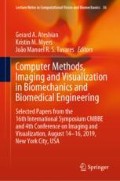Abstract
Vertebral Body Tethering (VBT) surgery for skeletally immature idiopathic scoliosis (IS) patients involves anteriorly placed vertebral screws securing a deformable Polyethylene-Terephthalate (PET) tether. Before securing the tether, compressive force is applied between the screw heads along the axis of the spine. There are no clear guidelines regarding the force magnitude required to optimize deformity correction. In the current study, a validated, patient-specific finite element (FE) model of the thoracolumbar spine/ribcage for a 10-year-old IS patient was analysed, to investigate the effect of four different VBT loading scenarios on spinal alignment and biomechanics.
The patient-specific FEM was previously validated using clinical results for pre-/post-operative deformity. Linear elastic continuum elements (PET material) were used to tether laterally oriented screws at spinal levels T5–T12, with roughened contact simulating the screws when locked onto the tether. Compressive forces measured intra-operatively during VBT and during anterior scoliosis fusion surgery (FS) were the basis for the four loadcases. The inferior L5 endplate was fixed.
After the surgical loadcases, patient-specific, level-wise gravitational loads at all vertebral levels simulated standing. In this preliminary series of VBT analyses, model predictions for corrected Cobb angle/Kyphosis angle/Axial trunk rotation, correction in major curve intervertebral disc wedge angle; and vertebral bone stress, were compared to determine how different surgical tether tension magnitudes affected deformity correction/spinal loading.
Results demonstrated varying degrees of improvement in coronal deformity correction could be achieved with different patterns of tethering loads. However, resultant loads on surrounding anatomy must be considered, with associated high spinal tissue loads and increased propensity for asymmetric growth modulation with increasing tether forces.
Access this chapter
Tax calculation will be finalised at checkout
Purchases are for personal use only
References
Crawford, C.H., Lenke, L.G.: Growth modulation by means of anterior tethering resulting in progressive correction of juvenile idiopathic scoliosis: a case report. JBJS (Am) 92(1), 202–209 (2010)
Samdani, A.F., Ames, R.J., Kimball, J.S., Pahys, J.M., Grewal, H., Pelletier, G.J., Betz, R.R.: Anterior vertebral body tethering for idiopathic scoliosis. Spine 39(20), 1688–1693 (2014)
Samdani, A.F., Ames, R.J., Kimball, J.S., Pahys, J.M., Grewal, H., Pelletier, G.J., Betz, R.R.: Anterior vertebral body tethering for immature adolescent scoliosis: one-year results on the first 32 patients. Eur. Spine J. 24, 1533–1539 (2015)
Joshi, V., Cassivi, S.D., Milbrandt, T.A., Larson, A.N.: Video-assisted thoracoscopic anterior vertebral body tethering for the correction of adolescent idiopathic scoliosis of the spine. Eur. J. Cardiothorac. Surg. 54, 1134–1136 (2018)
Newton, P., Fricka, K.B., Lee, S.S., Farnsworth, C.L., Cox, T.G., Mahar, A.T.: A symmetrical flexible tethering of spine growth in an immature bovine model. Spine 27(7), 689–693 (2002)
Courvoisier, A., Eid, A., Bourgeois, E., Griffet, J.: Growth tethering devices for idiopathic scoliosis. Exp. Rev. 12(4), 449 (2015)
Stokes, I.A.: Analysis and simulation of progressive adolescent scoliosis by biomechanical growth modulation. Eur. Spine J. 16, 1621–1628 (2007)
Cobetto, N., Parent, S., Aubin, C.E.: 3D correction over 2 years with anterior vertebral body growth modulation: a finite element analysis of screw positioning, cable tensioning and postoperative functional activities. Clin. Biomech. (Bristol, Avon) 51, 26–33 (2018)
Lavelle, W.F., Moldavsky, M., Cai, Y., Ordway, N.R., Bucklen, B.S.: An initial biomechanical investigation o fusionless anteiror tether constructs for controlled scoliosis correction. Spine J. 16, 408–413 (2016)
Newton, P., Farnsworth, C.L., Upasani, V.V., Chambers, R.C., Varley, E., Tsutsui, S.: Effects of intraoperative tensioning of an anterolateral spinal tether on spinal growth modulation in a porcine model. Spine 36(2), 109–117 (2011)
Braun, J.T., Hoffman, M., Akyuz, E., Ogilvie, J.W., Brodke, D.S., Bachus, K.N.: Mechanical modulation of vertebral growth in the fusionless treatment of progressive scoliosis in an experimental model. Spine 31(12), 1314–1320 (2006)
Little, J.P., Adam, C.J.: Patient-specific modelling of scoliosis. In: Gefen, A. (ed.) Patient-Specific Modelling in Tomorrow’s Medicine. Springer, Berlin (2012)
Little, J.P., Adam, C.J.: The effect of soft tissue properties on spinal flexibility in scoliosis: biomechanical simulation of fulcrum bending. Spine 34(2), E76–E82 (2009). (Phila Pa 1976)
Kamimura, M., Kinoshita, T., Itoh, H., Yuzawa, Y., Takahashi, J., Hirabayashi, H., Nakamura, I.: Preoperative CT examination for accurate and safe anterior spinal instrumentation surgery with endoscopic approach. J. Spinal Disord. Tech. 15(1), 47–51 (2002). discussion 51–42
Little, J.P., Adam, C.J.: Geometric sensitivity of patient-specific finite element models of the spine to variability in user-selected anatomical landmarks. Comput. Methods Biomech. Biomed. Eng. 18(6), 676–688 (2014)
Little, J.P., Izatt, M., Labrom, R.D., Askin, G.N., Adam, C.J.: An FE investigation simulating intra-operative corrective forces applied to correct scoliosis deformity. Scoliosis Spinal Disord. 8(1), 9 (2013)
Fairhurst, H., Little, J.P., Adam, C.J.: Intra-operative measurement of applied forces during anterior scoliosis correction. Clin. Biomech. (Bristol, Avon) 40, 68–73 (2016)
Fredriks, A.M., van Burren, S., van Heel, W.J.M., Kijkman-Neerincx, R.H.M., Verloove-Vanhorick, S.P., Wit, J.M.: Nationwide age references for sitting height, leg length, and sitting height/height ratio, and their diagnostic value for disproportionate growth disorders. Arch. Dis. Child. 90, 807–812 (2005)
Keaveny, T.M., Morgan, E.F., Niebur, G.L., Yeh, O.C.: Biomechanics of trabecular bone. Ann. Rev. Biomed. Eng. 3, 307–333 (2001)
Rohlmann, A., Richter, M., Zander, T., Klockner, C., Bergmann, G.: Effect of different surgical strategies on screw forces after correction of scoliosis with a VDS implant. Eur. Spine J. 15(4), 457–464 (2006)
Author information
Authors and Affiliations
Corresponding author
Editor information
Editors and Affiliations
Rights and permissions
Copyright information
© 2020 The Editor(s) (if applicable) and The Author(s), under exclusive license to Springer Nature Switzerland AG
About this paper
Cite this paper
Little, J.P., Labrom, R.D., Askin, G.N. (2020). A Preliminary Sensitivity Study of Vertebral Tethering Configurations Using a Patient-Specific Finite Element Model of Idiopathic Scoliosis. In: Ateshian, G., Myers, K., Tavares, J. (eds) Computer Methods, Imaging and Visualization in Biomechanics and Biomedical Engineering. CMBBE 2019. Lecture Notes in Computational Vision and Biomechanics, vol 36. Springer, Cham. https://doi.org/10.1007/978-3-030-43195-2_9
Download citation
DOI: https://doi.org/10.1007/978-3-030-43195-2_9
Published:
Publisher Name: Springer, Cham
Print ISBN: 978-3-030-43194-5
Online ISBN: 978-3-030-43195-2
eBook Packages: EngineeringEngineering (R0)

